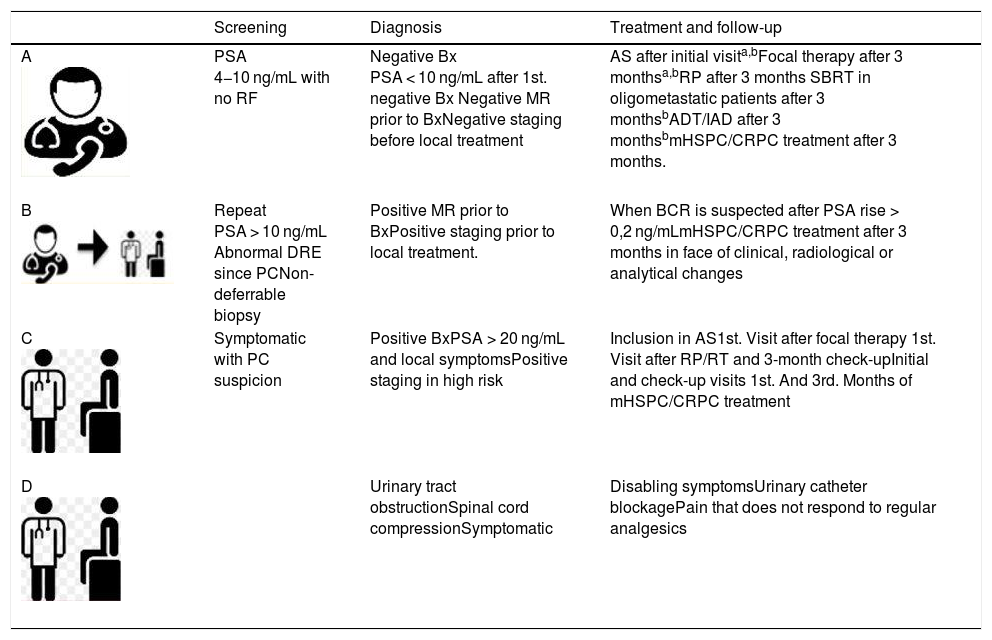The COVID-19 pandemic has brought about changes in the management of urology patients, especially those with prostate cancer.
The aim of this work is to show the changes in the ambulatory care practices by individualized telematic care for each patient profile.
Materials and methodsArticles published from March 2020 to January 2021 were reviewed. We selected those that provided the highest levels of evidence regarding risk in different aspects: screening, diagnosis, treatment and follow-up of prostate cancer.
ResultsWe developed a classification system based on priorities, at different stages of the disease (screening, diagnosis, treatment and follow-up) to which the type of care given, in-person or telephone visits, was adapted. We established 4 options, as follows: in priority A or low, care will be given by telephone in all cases; in priority B or intermediate, if patients are considered subsidiary of an in-person visit after telephone consultation, they will be scheduled within 3 months; in priority C or high, patients will be seen in person within a margin from 1 to 3 months and in priority D or very high, patients must always be seen in person within a margin of up to 48 h and considered very preferential.
ConclusionsTelematic care in prostate cancer offers an opportunity to develop new performance and follow-up protocols, which should be thoroughly analyzed in future studies, in order to create a safe environment and guarantee oncologic outcomes for patients.
La pandemia por COVID-19 ha supuesto un cambio en la atención a pacientes en el ámbito urológico, especialmente con cáncer de próstata.
El objetivo de este trabajo es mostrar los cambios en el manejo a nivel ambulatorio individualizando para cada perfil de paciente la atención telemática.
Materiales y métodosSe han revisado artículos publicados desde marzo del 2020 hasta enero del 2021. Se han seleccionado aquellos que aportaban los mayores niveles de evidencia en cuanto al riesgo en distintos aspectos: cribado, diagnóstico, tratamiento y seguimiento del cáncer de próstata.
ResultadosDesarrollamos una clasificación según prioridades, en diferentes etapas de la enfermedad (cribado, diagnóstico, tratamiento y seguimiento) adaptando a esta el tipo de control: presencial o telefónico. Establecemos 4 opciones: prioridad A o baja, en la que la atención será telefónica en todos los casos; prioridad B o intermedia, en la que si el paciente valorado telefónicamente se considera subsidiario de visita presencial, esta se citará dentro de los 3 meses posteriores; prioridad C o alta, el paciente será visto presencial con un margen para la visita de 1 a 3 meses, y prioridad D o muy alta, la visita deberá ser siempre presencial con un margen de hasta 48 h y considerada muy preferente.
ConclusionesLa atención telemática en cáncer de próstata representa una oportunidad para desarrollar nuevos protocolos de actuación y seguimiento que deberán ser analizados exhaustivamente en futuros trabajos con el fin de conformar un entorno seguro y garantizar resultados oncológicos para los pacientes.
Artículo
Comprando el artículo el PDF del mismo podrá ser descargado
Precio 19,34 €
Comprar ahora












